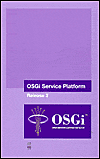OSGi Service Platform: Release 2
The Open Service Gateway Initiative was created in March of 1999. From that early start of 15 member companies it has now grown to more than 80, with meetings of over 150 people, held three times a year all over the planet. When they started this work the original intention was to create a specification to allow services to be remotely deployed onto home network gateways. This document is the product of the Core Platform Expert Group. The result of the expansion of the last few years of OSGi is that it now exists to create open specifications for the managed delivery of multiple services over wide-area networks to local networks and devices. It's become apparent that OSGi principles are applicable in any environment where managed lifecycles, long uptimes and highly resilient, remotely managed platforms are requirements. Some of the early results of the expansion of focus can be found in this document; new API's such as Preferences and User Administration have been added and all of the existing capabilities have been enhanced. Despite this, one thing OSGi's been very careful with is to not alienate the early adopters, so there are very few incompatibilities between this specification and earlier ones.
"1112373093"
OSGi Service Platform: Release 2
The Open Service Gateway Initiative was created in March of 1999. From that early start of 15 member companies it has now grown to more than 80, with meetings of over 150 people, held three times a year all over the planet. When they started this work the original intention was to create a specification to allow services to be remotely deployed onto home network gateways. This document is the product of the Core Platform Expert Group. The result of the expansion of the last few years of OSGi is that it now exists to create open specifications for the managed delivery of multiple services over wide-area networks to local networks and devices. It's become apparent that OSGi principles are applicable in any environment where managed lifecycles, long uptimes and highly resilient, remotely managed platforms are requirements. Some of the early results of the expansion of focus can be found in this document; new API's such as Preferences and User Administration have been added and all of the existing capabilities have been enhanced. Despite this, one thing OSGi's been very careful with is to not alienate the early adopters, so there are very few incompatibilities between this specification and earlier ones.
97.0
In Stock
5
1

OSGi Service Platform: Release 2
352
OSGi Service Platform: Release 2
352Hardcover
$97.00
97.0
In Stock

Product Details
| ISBN-13: | 9781586032524 |
|---|---|
| Publisher: | IOS Press, Incorporated |
| Publication date: | 07/28/2002 |
| Pages: | 352 |
| Product dimensions: | 6.40(w) x 9.70(h) x 1.00(d) |
From the B&N Reads Blog
